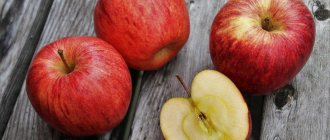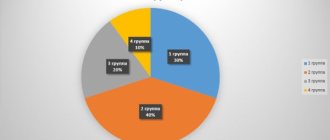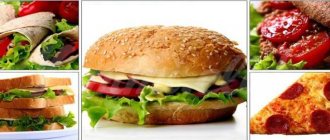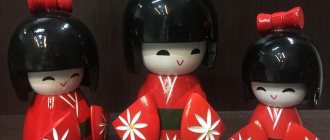More recently, nutritionists have come to believe that the blood type diet is one of the most optimal ways to lose weight. By losing weight in this way, a person not only corrects his figure, but also maintains health, taking into account the characteristics of his body. Let's figure out what the features of nutrition are based on blood type.
Contraindications
We hasten to please you - there are practically no contraindications! Perhaps individual intolerance to certain foods. But they can always be replaced with others - the choice is quite wide. In many “hard” diets (you will be interested to read about them - Kefir diet, Buckwheat diet) the list of substitutes is much shorter.
In some diseases, eating certain foods (recommended for you) can be harmful, and the absence of other ("bad" for you) nutrients will not help you heal. For example, with hypertension or heart disease, the amount of meat should be limited even for people in group 1, where meat is the basis of the diet. On the contrary, in case of anemia or protein deficiency, meat cannot be excluded, even if dairy or plant foods are recommended to you.
In addition, a person’s condition changes with age. For example, osteoporosis develops, in which calcium is needed. Therefore, even “meat eaters” should not remove dairy dishes from the menu. Hence the conclusion - in case of illness or age-related changes, follow any diet - only after consulting a doctor! It is especially important for those with kidney disease, liver disease (in this case it is better to adhere to a special nutrition system), diabetes, and coronary artery disease.
There is also no data on the benefits of any diet for children or adolescents. To be fair, it should be noted that a set of well-known healthy dietary products is recommended for representatives of each group.
Reviews of those losing weight
I first went to a special clinic that develops an individual blood diet. But later I studied the information on my own and, adhering to the recommendations received, was able to easily lose 5 kg.
Svetlana
During pregnancy I gained 30 extra pounds! My weight was 85.5 kg. with a height of 171 cm. I was on a weight loss diet for 2 years. Now my weight is 52 kilograms (3 less than before pregnancy). And I feel great!
Irina
I consider eating according to blood type to be a placebo effect. It didn't help me at all.
Michael
After giving birth, I tried to follow such a diet under the supervision of a nutritionist. I lost a couple of pounds, but it seems to me that my diet would be suitable for anyone to lose weight: low-fat dairy products, turkey, vegetables and fruits. Potatoes, flour, sausage and other “harmful things” were not allowed. I think it's 2 kg. - no result at all. Although my friend lost 10 kg using this method. I think it's all individual.
Victoria
Diet according to blood group 1 (I)
I (or O according to the international classification), according to Dr. D'Adamo's theory, belonged to hunters - the first people on Earth. It was formed about 30 thousand years ago. The basis of the hunters' diet was meat. It is assumed that the representatives of the others descended from the first as a result of natural selection. Nowadays, about a third of the world's population has the former.
According to the concept of blood nutrition, all “descendants of hunters” are prescribed a high-protein diet with a predominance of animal protein. This is red lean meat (lamb or beef), seafood, sea fish (especially fatty varieties), liver, and other offal. Red meat is a source of protein, iron, vitamin B, and many seafood are also excellent sources of iodine, which regulates thyroid function.
Vegetables should be leafy, as well as broccoli and artichokes. Oil is best olive oil. The source of microelements important for a protein diet will be sprouted grains, walnuts, prunes, and figs. Dark red, blue and purple fruits tend to cause an alkaline reaction in the gastrointestinal tract, therefore neutralizing high acidity. They are allowed. Products with gluten (rye, oats, wheat), dairy (especially fatty foods), eggs, cabbage/cauliflower, legumes, and corn are contraindicated for hunters. All of them slow down metabolism and lead to weight gain.
Pickles that cause fermentation (for example, cabbage or apples), including juices from them, are also not suitable. The best drinks for hunters are rosehip infusion or mint tea. In general, representatives of group I, as a rule, have a strong digestive tract, although they sometimes have gastritis due to the increased acidity of gastric juice.
But being conservative in nutrition, it is difficult to tolerate unusual food. They definitely need to combine the right diet with physical activity - without this, the diet will not bring results. A more complete list (allowed, neutral, prohibited) can be found in the table.
Table of products for diet group 1
| Allowed | Neutral | Prohibited |
| Beef, lamb, veal, venison | Any meat except prohibited types | Bacon, ham, goose, pork |
| Cod, herring, mackerel | Any fish or seafood, except those prohibited | Pickled herring, catfish, smoked salmon, caviar, octopus, scallops |
| Olive and linseed oil | Butter, Feta cheese, Mozzarella cheese, goat or soy milk cheese | All other dairy products and yoghurts |
| Pumpkin seeds and walnuts | Rapeseed oil, sesame oil | Corn, peanut, cottonseed and safflower oil |
| Spotted beans | Barley, buckwheat, rice, pearl barley, buckwheat flour, rye bread | Brazil nuts, cashews, peanuts, pistachios, poppy seeds |
| Kale, greens, romaine lettuce, broccoli, spinach | Grapefruit, most berries | Lentils red and green |
| Artichoke, chicory, dandelion, garlic, horseradish, cabbage, leek, parsley, parsnip, red pepper, sweet, pumpkin, seaweed, turnip | Chocolate, honey, cocoa | Corn, wheat (bulgur, durum, sprouted, white and other wheat, germ and bran), starch, oatmeal. Any foods such as flour, bread and noodles |
| Plums, prunes, figs | Wine | Cabbage, Brussels sprouts, cauliflower, mustard greens |
| Kelp and seasonings based on it, iodized salt | Alfalfa sprouts, shitake mushrooms, fermented olives | |
| Parsley, curry, cayenne pepper | Nightshades: eggplant, potatoes | |
| Water and teas, including herbal ones | Corn | |
| Avocado | ||
| Oranges, tangerines and strawberries, blackberries, rhubarb, melons | ||
| White and black pepper, vinegar, capers, cinnamon, cornstarch, corn syrup, nutmeg, vanilla | ||
| Ketchup, pickles, mayonnaise | ||
| Beer, coffee, black tea |
Diet for blood group 2 (II)
II (or A) was formed about 20 thousand years ago among our ancestors with the development of agriculture. The food of farmers was mainly plant-based, so their “descendants” are more suitable for vegetarianism than others; there are about 38% of those on earth.
The basis of their diet should be cereals, vegetable oils, cereals (gluten-containing ones - limit!), fruits (apricots, lemons, plums, figs, pineapples). It is better to exclude meat (especially red) completely, but fish and seafood will be beneficial. Vegetables are vital for people of group 2, providing minerals, enzymes, and antioxidants. They can be eaten raw, steamed or stewed.
Health problems and excess weight among “farmers” are expected due to dairy foods, which are poorly digestible and slow down metabolism, products made from wheat flour (gluten protein, which is abundant in wheat, reduces the effect of insulin), beans (difficult to digest due to for its high protein content). Tomatoes, potatoes, mushrooms, eggplants, and fruits such as melon, bananas, oranges and mangoes are not recommended. It is better to refrain from orange juice, as well as black tea and any carbonated drinks.
In general, the digestive system of “farmers” is quite resilient - provided it is fed properly. If you abuse meat and dairy products, there is a high risk of heart disease, cancer, and diabetes. The right combination of spices will be a powerful helper for the immune system. The exception is those whose acids cause irritation of the gastric mucosa: vinegar, pepper. Condiments such as ketchup and mayonnaise should be avoided, as members of group 2 have increased levels of stomach acid.
A more complete list of foods (allowed, neutral, prohibited) for the diet can be found in the table.
Table of foods for blood group 2
| Useful | Neutral | Prohibited |
| Carp, cod, sea bass, mackerel, red snapper, rainbow trout, salmon, sardines, sea trout, silver perch, whitefish, yellow perch | Chicken meat | Beef, pork, lamb, veal, venison, duck, goose |
| Flaxseed oil, olive oil | Yogurt, Mozzarella and Feta cheeses, goat cheese, goat milk, kefir, ricotta | Anchovies, beluga, catfish, caviar, shells, crabs, crayfish, eel, flounder, hake, halibut, herring, lobster, mussels, octopus, oysters, scallops, shrimp, squid |
| Peanuts, pumpkin seeds | Cod liver oil | All cheeses and milk, except neutral ones |
| Spotted beans | White beans, green beans | Corn, cottonseed, peanut, sunflower and sesame oil |
| Buckwheat, rye | Pearl barley, barley, rice, barley, oat and corn flakes | Brazil nuts, cashews, pistachios |
| Soy and rye breads, rice cakes, flours (oat, rice, rye), noodles and pasta and rice or rye | Coriander, cinnamon, cloves, vanilla, bay leaf | Black beans |
| Garlic, onion, broccoli, carrots, greens, pumpkin, spinach | Semolina, corn, rye | |
| Artichokes, chicory, greens, dandelion, horseradish, leeks, romaine, parsley, alfalfa sprouts, tofu, turnips | Products made from semolina flour or durum wheat, muesli, grain bread, wheat flakes | |
| Berries (blackberries, blueberries, cranberries), plums, prunes, figs, grapefruit, lemon | Peppers, olives, potatoes, sweet potatoes, yams, all types of cabbage, tomatoes, eggplants, mushrooms | |
| Pineapples, cherries, apricots | Acidic vegetables, especially tomatoes | |
| Soy sauce, garlic, ginger | Melons, honeydew, mango, papaya, bananas, coconuts | |
| Hawthorn, aloe, burdock, echinacea, green tea, red wine (1 glass/day) | Orange, rhubarb, tangerines | |
| Ginger tea, coffee (1 cup/day) | Vinegar, pepper (black, cayenne, white), capers, gelatin | |
| Ketchup, mayonnaise, pickles | ||
| Beer, sparkling water, black tea |
General recommendations
The menu is selected for each blood group, taking into account indications for improving the patient’s health and losing weight:
- For the first - food with a maximum protein content. Undesirable products - cereals.
- For the second - food of plant origin. Undesirable products - containing a maximum amount of animal fats.
- For the third - a diet based on a balance of products of plant and animal origin. The exception is seafood and pork.
- For the fourth - food with a moderate content of all products. Lean meat and fish are especially desirable in the diet.

Diet for group 3 (III)
Representatives of III (or B) are descendants of nomads who appeared about 10 thousand years ago with the beginning of mass migration of peoples.
Nomads are practically omnivores, their bodies are hardy and unpretentious. Although some may be intolerant to the lactose contained in milk. The diet for carriers of this group is the most balanced of all - meat, fish (especially sea fish), cereals (except wheat and buckwheat), and dairy products are suitable for “nomads”. And also almost any fruits and vegetables (except tomatoes, corn, melons).
Most nuts and seeds are not recommended, and almost all legumes are prohibited or can be consumed in small quantities. Many grains are not recommended, for example, rye contains lectin, which settles in the vascular system, causing blood diseases and increasing the likelihood of strokes. These foods contribute to a sluggish metabolism, fluid retention and fatigue.
Spices should be used with caution. It is better not to use pepper, cinnamon and gelatin, but ginger and curry have a warming effect.
Representatives of this type rarely need to lose weight; they most often need a diet to improve health and maintain immunity. Despite their flexibility and amazing endurance, modern “nomads” are not resistant to rare viruses, are susceptible to autoimmune diseases and often suffer from chronic fatigue syndrome. A more complete list (allowed, neutral, prohibited) for the diet can be found in the table.
Products for blood group 3
| useful | Neutral | Prohibited |
| Lamb, venison, rabbit | Beef, ground beef, turkey, liver, veal | Chicken, duck, goose, partridge, quail, pork |
| Cod, salmon, flounder, halibut, trout, mackerel, sturgeon | Flaxseed, cod liver oil, butter | Shellfish (crabs, shrimp, lobster, mussels, oysters, crayfish, clams, etc.), anchovy, beluga, eel, octopus, sea bass, snails, seaweed |
| Cottage cheese, Feta and Mozzarella cheese, yoghurts, milk, sour cream, curd cheese | Almonds, walnuts | Ice cream |
| Olive oil | Peas, green peas, white beans, green beans | Rapeseed, corn, cottonseed, peanut, safflower, sesame, sunflower oil |
| Millet, oatmeal (bran, flour), puffed rice, rice (bran, flour) | Cashews, hazelnuts, pine, pistachios, peanuts, pumpkin seeds, sesame seeds, sunflower seeds | |
| Wheat bread, rice cakes and waffles | Black beans, spotted beans, lentils | |
| Green leafy vegetables | Wheat (bran, germ, bulgur, white and durum), semolina or any products such as flour, bread and noodles made from this grain | |
| Pineapples | Rye and any products made from this grain | |
| Bananas, cranberries, grapes, papaya, plums | Buckwheat, corn (corn flakes, corn flour) and products made from this grain | |
| Ginger, horseradish, curry, cayenne pepper | Barley, wild rice, couscous | |
| Ginger, peppermint, raspberry leaf, rose hips, sage, green tea | Bagels, baked goods, grain bread, rye bread | |
| Ginseng | Artichoke, avocado, corn, olives, pumpkin, radish, cabbage, tofu, tomato | |
| Liquorice | Coconuts, persimmons, pomegranates, prickly pear, rhubarb, carom | |
| Barley malt sweeteners, corn syrup, corn starch, cinnamon | ||
| Allspice, almond extract, gelatin, pepper (black and white) | ||
| Ketchup, mayonnaise | ||
| Aloe, corn silk, fenugreek, gentian, hops, linden, mullein, red clover, rhubarb, shepherd's purse | ||
| Alcoholic drinks, sparkling water |
Diet for blood group 4 (IV)
IV (or AB) is the youngest and most mysterious. It arose less than a thousand years ago as a result of a mixture of the first two groups, it is found in only 7% of the world's population, they can conditionally be called “city dwellers”. Both recommendations and prohibitions for “city dwellers” can be quite unexpected.
They are shown caviar, fish, all types of soybeans (especially tofu cheese), dry red wine, rice, dairy products, green fruits, and vegetables. Type 4 usually suffers from gall bladder problems, so nuts should be eaten with caution. But permitted varieties of nuts will strengthen the immune system. It is recommended to eat lentils as they contain anti-cancer antioxidants.
You should abstain from red meat and meat products, mushrooms, buckwheat, beans, wheat, and corn. Tropical fruits are difficult to digest, but pineapple is a good helper for the stomach. Fruits rich in vitamin C can help fight stomach cancer.
Representatives of this group usually have a weak digestive tract and are prone to cancer and nervous disorders. At the same time, they adapt well to the constantly changing conditions of the modern world. To maintain health, vitamins and microelements are vital for them.
If you want to lose weight, eat more rice instead of pasta. And fresh vegetables will be an important source of elements that fight cancer and prevent heart disease. Herbal teas are very useful for “city dwellers” - they improve immunity, prevent cardiovascular diseases and anemia. A little coffee won't hurt, but alcoholic drinks have a negative effect. The full list can be viewed in the table.
Table of foods for 4 blood groups
| Useful | Neutral | Prohibited |
| Lamb, rabbit, turkey | Pistachios, pine nuts | Beef, chicken, duck, geese, pork, veal, venison, ham |
| Tuna, cod, sea bass, hake, mackerel, sea bass, pike, trout, sardines, sturgeon, caviar, salmon, pike perch, trout, pike | Peas in any form, white beans, green beans | All shellfish, halibut, crustaceans, herring, eel and hake |
| Yogurt, kefir, low-fat sour cream, egg, mozzarella, goat cheese and milk, ricotta | Blue cheese, brie, buttermilk, camembert, ice cream, parmesan, whole milk | |
| Olive oil | Oils: corn, cottonseed, safflower, sesame, sunflower | |
| Peanuts, walnuts, poppy seeds | Hazelnuts, pumpkin seeds, sesame seeds, sunflower seeds | |
| Lentils | Black beans | |
| Soybeans, spotted beans, lentils | Buckwheat, corn (any products such as flour, bread and noodles made from them) | |
| Millet, oat bran, oat flour, rice bran, puffed rice, rye, sprouted wheat and any products such as flour, bread and noodles made from them | Artichoke, avocado, black olives, all types of peppers | |
| All types of rice and any products such as flour, bread and noodles made from it | Mango, guava, coconuts, bananas, oranges | |
| Broccoli, beets, cabbage, celery, green leafy vegetables, cucumbers, eggplant, garlic, parsley, parsnips, sweet potatoes | Allspice, almond extract, anise, barley malt, capers, corn starch, corn syrup, gelatin, tapioca | |
| All types of grapes and plums, berries (cranberries, gooseberries), cherries | Vinegar, pepper (white, black, cayenne, red flakes) These vegetables are a powerful tonic and natural antibiotic for the 4th group Garlic, horseradish, parsley | |
| Pineapples, grapefruits, lemons | Alcohol, carbonated drinks, black tea | |
| Kiwi | ||
| Kelp, curry | ||
| Garlic, horseradish, parsley | ||
| Alfalfa, burdock, chamomile, echinacea, green tea | ||
| Hawthorn, licorice root, red wine (1 glass/day) | ||
| Dandelion, burdock root, strawberry leaves | ||
| Coffee or decaffeinated coffee (1 cup/day), green tea |
Advantages and disadvantages of the diet
The main disadvantage of this diet is that it is not suitable for rapid weight loss. Those who want to lose weight in a month or three are better off choosing another diet (for example, the Kremlin diet). This system is designed for long-term (preferably lifelong) use and brings health improvement to the body, strengthening the immune system, normalizing digestion, and as a result, weight loss.
Another argument of critics of this approach to nutrition is the lack of serious scientific research. Nevertheless, the diet has a sufficient number of fans around the world, and the number of positive reviews about it is growing.
Discussion of diet in the program Malakhov+
Diet for weight loss
A weight loss diet based on a person's blood type was developed by scientists to achieve noticeable weight loss results without harming the body. As reviews from those who have lost weight say, a person can eat everything from the menu intended specifically for him, without limiting himself in the amount of food consumed. However, this weight loss system is effective only when the entire process occurs under the supervision of a nutritionist.
Each type has its pros and cons, which are fundamental links in building a diet:
- The first blood group is characterized by an excellent immune system and stable digestion, high activity and good metabolism. The negative aspects include aversion to sudden changes in diet, a tendency to allergic reactions and inflammation.
- The second group belongs to people with immunity to changes in living conditions. They are distinguished by a weak gastrointestinal tract, frequent diseases of the gallbladder, pancreas and kidneys.
- The third blood group is people with nerves of iron and good immunity. If there are metabolic failures, there is a high probability of heart disease, vascular disease, and cancerous tumors. They are highly susceptible to viral infections.
- The fourth group is typical for people who have all the pros and cons of types 2 and 3.











